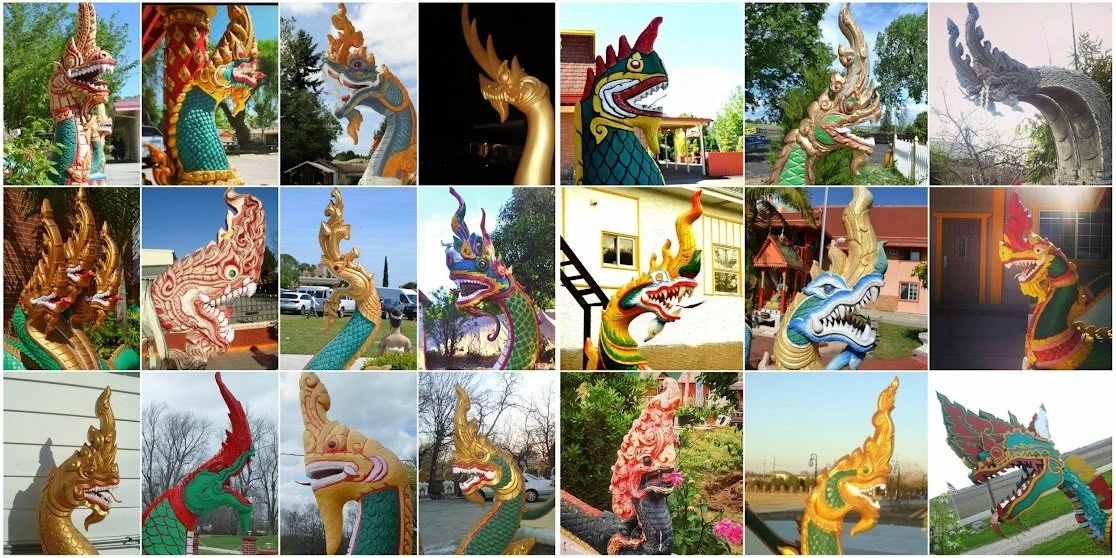This April, the Lao community across the globe will observe the arrival of Year of the Nak, and with it come a number of questions about how we might well observe the occasion and what we might say about the Nak, which we feel is far more than what the English word “dragon” describes. The Nak, or Naga, is considered a sacred demigod with roots in Hindu and Buddhist religious tradition as one of the 8 major species particularly entrusted with protecting cosmic truths. Some romance humans or seek enlightenment, but they are not usually said to have souls the way that humans do.
Nak serve as the guardians of Lao Buddhist temples around the world, and are most often the primary mythological creature depicted in Lao temples or wat, compared to a giant Nyak or Khut/Garuda bird guardian. We can usually consider them distinct from the Chinese Lung, the Vietnamese Rong, the Japanese Ryu, or the Hmong Zaj, but they are largely similar to their counterparts in the Myanmar, Khmer, Thai, Malaysian and other ASEAN nations.
The Nak are known as shapeshifters, most often depicted as divine titanic serpents, often with many heads. They dwell in rivers or beneath the earth, associated with magic and water, including the rains and floods, as well as fertility. Some sources suggest Nak with even heads are female, while those with odd numbers of heads are male. Nakinee or Nagini are said to be the female forms of the Nak. They’re rarely depicted in Lao art, compared to males. They are considered bringers of treasures, notably wisdom. Most Nak are considered kind but they all despise those who pollute waters, caverns or sacred spots.
Lao Buddhist temples frequently have many Nak around the grounds, with at least one pair that is very unique from the other statues and paintings that might be found at other temples, particularly in the United States.

In The Enduring Sacred Landscape of the Naga (Mekong Press, 2009), the Ngaosrivathanas identify at least fifteen Nak in Luang Prabang and nine in Vientiane. They note that in one inventory, 1,024 distinct species of Nak were identified. While generally considered protective, Nak are noted as ruthless and fierce against their enemies. Nak will devour a foe or inflict terrible diseases upon those who violate customs or pollute the environment, particularly their sacred homes.
The Nak appear in many key myths and legends of Lao culture, including Phra Lak Phra Lam (our version of the Ramayana or Ramakien), the story of the Buddha, and Phadaeng Nang Ai to name just a few. In one of his former lives, the Buddha is said to have been a Nak prince named Bhuridatta. At least eight Nak kings were said to have attended the Buddha’s lecture on Vulture Peak according to the White Lotus Sutra.
Many Lao get tattoos of the Nak, particularly Phaya Nak, the king or lord of the Nak. Each year, there are festivals by the Mekong River watching for Nak fireballs that come out at night. In Laos, the Nak tends to vary between depictions that make it similar to a cobra or a constrictor like python. Young Lao Buddhist monks are referred to as Nak in memory of a legendary Nak who tried to be a disciple of the Buddha in the early years of his enlightenment. Besides several locations throughout Laos and the Mekong river, the Nak are said to be found in locales such as Patala (or Nagaloka), and its capital Bhoga-vatī. Lake Manosarowar, Mount Meru (or Sumeru), Nagpur, the Pacific Ocean, Nagadaa, Anantnag, and Takshila are also places they are said to reside.
In the 20th century, reports of Nak from have suggested their size in the Mekong ranges from 3 to 25 meters. Others have suggested that the legends of the Nak are based upon sightings of the oarfish. This seems somewhat unusual, given that the Mekong River is generally considered to be about 300 feet deep, while the oarfish prefer oceanic depths in excess of 600 feet. But stranger things, perhaps.
The Nak is the only mythological creature of the Lao zodiac. There aren’t extensive conversations on the differences between a Chinese Lung and a Lao Nak but it seems safe to say that in both cultures, they are seen as powerful, wise, noble, pioneering and lucky. They are usually associated with people who are confident, ambitious, and kind.
Children born in the year of the Nak are said to be prone to exhibiting bad habits of being self-centered, temperamental and gullible, but many mature out of this. They are said to be most compatible with those born in the year of the Rat, Monkey, and Rooster, but not as much with Dogs and Rabbits. However, this is mostly anecdotal, and should definitely be treated with some skepticism.
The years of the Nak for our community of the last century included 1892, 1904, 1916, 1928, 1940, 1952, 1964, 1976, 1988, 2000, and 2012, with the next year being 2036. Students of Lao and world history will note that several of these years coincide with significant events that changed much of how we interacted with one another, especially since arriving in the US.
It remains to be seen what will unfold over the next 12 months for our community, even as the United States holds its next presidential elections in November, but we suspect it will be very exciting. In 2025, we will welcome the year of the Snake, which is also typically seen as a figure of growth and wisdom in Laos. But have a great Pi Mai Lao, however and wherever you celebrate this year!
